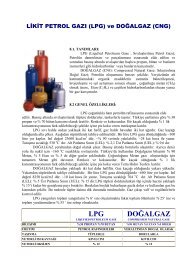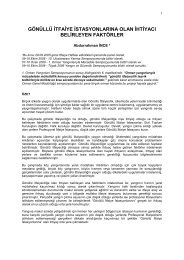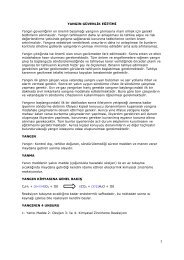buradan - Yangın
buradan - Yangın
buradan - Yangın
Create successful ePaper yourself
Turn your PDF publications into a flip-book with our unique Google optimized e-Paper software.
Figure 5. Acquisition sections<br />
Figure 6. -40 m section<br />
Figure 7. +5 m section<br />
Figure 8. +840 m section<br />
BİLDİRİLER KİTABI TÜYAK<br />
PROCEEDINGS BOOK 2009<br />
At 40 m upstream sections temperature and air speed<br />
measurements were located at several heights (Figure 6). At 5 m<br />
downstream section temperature was measured (Figure 7) and at<br />
840 m downstream section temperature, air velocity, O 2 and CO<br />
concentration and humidity were measured (Figure 8).<br />
These measurements permitted to evaluate cooling capability of<br />
the water mist system and fire heat release in order to evaluate<br />
control and suppression capability. Calculation of heat released<br />
were based on oxygen consumption calorimetry technique.<br />
Water mist system was located above fire area located at 5.2 m height.<br />
Water was discharged in a single 50 m long section (Figure 9).<br />
Figure 9. Water mist system<br />
3. Fire Scenarios And Results<br />
30 MW Pool Fire:<br />
First scenario tested was a 6 diesel pool fire configuration. Each<br />
pool was 1.2 x 1.6 m with a heat release about 4 and 5 MW (Figure<br />
10).<br />
Additionally a target wood pallet and bucket of water were located<br />
at 6 m and 2.5 m downstream in order to evaluate water mist<br />
system capability to avoid fire spread and radiation attenuation to<br />
avoid tank vehicles to achieve dangerous temperature increase.<br />
Figure 10. Diesel pool fire configuration (top and side view)<br />
TÜYAK 2009<br />
5





